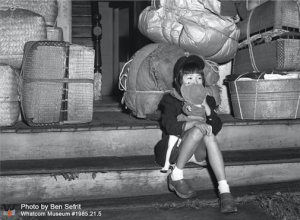In June, 1942, residents of Japanese origin are taken from Bellingham to internment camps.
***
After the bombing of Pearl Harbor in February, 1942, President Roosevelt signed an executive order authorizing the internment of all American citizens of Japanese ancestry and all other Japanese residents who lived along the West Coast.
On May 22, 1942, Bellingham’s residents with Japanese ancestry were instructed to report for registration at a Western Defense Command control center in Burlington.
At the time there were at least 33 residents with Japanese ancestry living in Bellingham, some of whom operated local businesses, including the Chili Parlor, Oka Dye Works, and the Sunrise Cafe.
On June 3, a bus took those who had not already left Bellingham to Burlington.

From there, they were taken by train to an internment camp at Tule Lake.

Nobuye “Pat” Shima (6 years old) being expelled from Bellingham. (June 4, 1942, Bellingham Herald).
Even before the federal internment, there is evidence of racism against residents of Japanese descent in Bellingham, as seen in this letter from that period.
Known Bellingham residents who went to Tule Lake included:
Nobuye Shima (pictured above)
Jim Okubo (Western student who became a war hero).
For more information, see:
Fumio Otsu’s talk on the Bellingham Japanese community’s internment during WWII.
Teshima, Carole, “Belllingham’s Japanese Residents Never Returned.” Journal of the Whatcom County Historical Society. Volume 1.
Presentation to the Whatcom County Historical Society on the Japanese internment.
Reeves, Richard, (2016) Infamy: The Shocking Story of the Japanese American Internment in World War II. New York: Henry Holt & Company.
Margaret Willson, (1982), An Ethnohistorical study of the Dominant Community Reaction to the Chinese and Japanese Immigrant Communities in Bellingham, Washington (WWU master’s thesis).
U.S. government’s 1988 reparation act recognizing the injustice and apologizing
